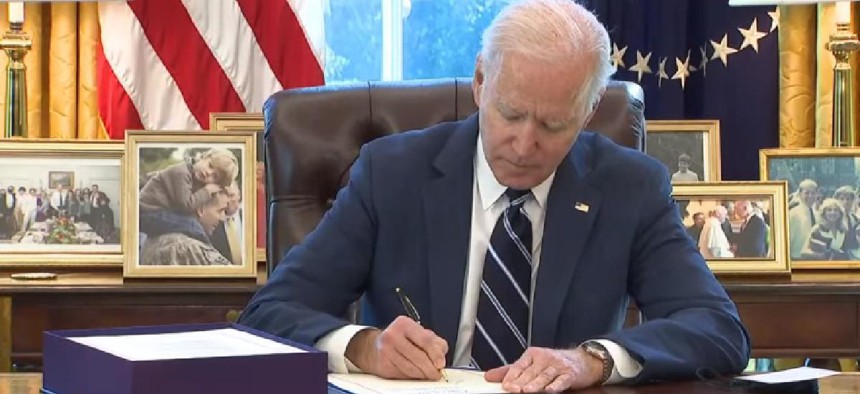Biden's first budget ups cyber and tech spending
The Biden administration released its $6 trillion fiscal year 2022 budget proposal on Friday, including $1.5 trillion in discretionary spending across federal agencies.
The Biden administration released its $6 trillion fiscal year 2022 budget proposal on Friday, including $1.5 trillion in discretionary spending across federal agencies.
The discretionary request seeks $769 billion on non-defense spending and $753 billion in defense programs. Of that, $715 billion is tabbed for the Department of Defense – essentially flat from 2021.
The proposal includes $58.4 billion in IT spending across civilian agencies. The aggregate figure for DOD IT spending was not broken out in the documents, but should eventually be posted to the federal IT dashboard. The FY2021 figure was $37.7 billion.
The Defense Department's fiscal 2022 could be a pivotal year for the organization's goal of advancing its technological capabilities with strong modernization investments in research and development and communications and computer systems.
Defense Secretary Lloyd Austin told House appropriators at a May 27 hearing that the $715 billion budget had "substantial investments" in nuclear modernization, missile defense, naval forces, long range fires and what could be the "largest ever request" for research, development, testing and evaluation.
The goal, he said, is to ensure "that we are focused on acquiring the right kinds of capabilities to be relevant in the future fight," the defense secretary said, and work with the military services to identify systems that will become irrelevant for increasingly tech and cyber-heavy warfighting needs.
There's $10.4 billion tagged for cyberspace activities in 2022, including defensive and cyber hygiene measures like incorporating zero trust and improving endpoint controls and credentialing. There's more emphasis put on defense industrial base cybersecurity and the number of cyber mission teams is growing across DOD.
Nearly $13 billion is carved out for command, control, communications, computers, and intelligence (C4I) spending, which includes buying for cyberspace activities, automation ($600 million), tech development ($3 billion), and information security and assurance ($1.6 billion). The majority of C4I investments are reserved for military operations under "theater combat command, control, computers and services" at $6.6 billion.
Gen. Mark Milley, the chairman of the Joint Chiefs of Staff, also testified May 27, saying the 2022 budget had a "bias on the future" compared to previous budgets that favored readiness efforts and that mastering -- something that is evident in the Army's budget request.
The Army's integrated visual augmented system, also known as augmented reality goggles, continue to be a breakout star in their $173 billion budget request with $854 million requested under other procurement for fiscal 2022. The Army hopes to get 29,237 more of the goggles, which aim to prepare and train soldiers for any environment. In 2021, the Army was approved to get 26,304 units.
One of the biggest increases for the Army is in software and digital technology RDT&E. The service doubled its request from fiscal 2021 to $119 million. The Army asked for nearly $300 million more for electronic equipment, primarily for tactical surveillance, command and control. Electronic warfare investment request dropped nearly 50% to $48 million, compared to $113 for fiscal 2021. However, automation gets a lift at $378 million, a $55 million increase over last year's enacted levels.
DOD is also requesting $436.5 million, a $25 million increase from last year, for Tactical Network Technology (TNT) modernization for the Army, which includes satellite and line of sight network connectivity. The Army is replacing outdated or non-sustainable components of its network over time with newer technologies that can handle cyber and electronic warfare needs.
"This budget addresses underperforming acquisition programs with unsustainable costs, adjusts funding to meet our overseas posture and operations needs, and divests in systems that lack the requisite capabilities so that we can invest in the emerging technologies needed to fight in the future security environment," Rep Adam Smith (D-Wash.), the chairman of the House Armed Services Committee, said in an emailed statement. "Planning for funding in the base budget, as this request does, represents an important budgetary reform that supports transparency, fiscal discipline, and sound and predictable defense planning."
A longer version of this article first appeared on FCW, a Defense Systems partner site.




